Edema
Asparagus Beetle
Flea Beetles
Imported Cabbageworm
The spring has continued to be a good one for drying out the soil, but cold temperatures are sticking around stubbornly. The national weather service has forecasted a relatively high probability of below normal temperatures for the next two weeks, at least.
Cool and cloudy conditions favor occurrences of edema, and frost can damage emerging asparagus spears.
Despite the chilly nights, daytime temperatures are warm enough to further the development of seedcorn/cabbage/onion maggot flies, and maggots have been spotted in southern New England. If you missed the previous Pest Report, you can read about them here.
There are also reports from southern New England that flea beetles and cabbage moths are becoming active, so keep an eye out and be prepared.
Reminder that most Pest Report photos can be viewed larger in a new window simply by clicking on them.
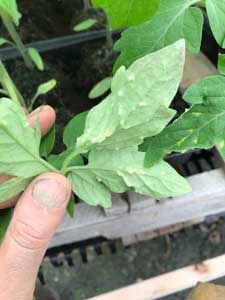 |
| Edema on tomato |
EDEMA (OEDEMA)
This time of the year it’s not uncommon for growers to be concerned by edema on their seedlings. It can look very much like a disease that “just came out of nowhere!” but is in fact a typically harmless physiological disorder.
Edema usually shows up on tomato seedlings when they have been waiting through lots of cloudy cold days. It is also a common problem in plants in the cabbage family, and some house plants.
Blisters or bumps appear on the surface of the leaves, usually the underside. The swellings initially appear pale-green, but they can erupt and turn yellow, brown or even black. Eventually, corky spots appear as the leaves heal over with scar tissue, and this is often the stage at which growers notice the condition. Older leaves are more often affected than younger leaves.
Edema is a physiological disorder that develops when a plant absorbs water faster than it can be lost from the leaf surface. Excess moisture builds and the blisters form. This is most commonly induced when transpiration is limited. Transpiration (the natural loss of water from the plant) is reduced by cloudy days, humid conditions in a greenhouse, cool temperatures, low light levels such as when plants are raised on a windowsill in a home, etc. Overwatering under these conditions is commonly the biggest factor causing the problem.
Leaves affected with edema never clear up, but the disorder is usually quickly forgotten as warmer sunnier days lead to fresh new growth without any of these symptoms. There are some steps that can be taken to prevent more of the problem:
- Cut back on watering when conditions favor edema, but, of course, do not let the plants completely dry out.
- Water only in the morning
- Supplement lighting if it is low
- Increase ventilation and avoid over-crowding plants
ASPARAGUS BEETLE, COMMON AND SPOTTED
By Eric Sideman
First Let Me Discuss Frost
One of the very first questions I received when I began working for MOFGA many, many years ago turned into an argument. Not a good start for my tenure, but I stuck it out. The guy who called would not believe me that asparagus is frost sensitive. His spears had turned dark, wrinkled and water-soaked. I don’t know if I ever convinced him that the problem was they were frosted. Perhaps he is reading this.
Asparagus, despite its status as a primo early season vegetable, is highly sensitive to frost, ranking alongside cucumber, snap beans, eggplant and tomatoes in the ‘most susceptible’ category. There is still a chance of frost damage.
When frosted, spears appear slightly darker green, water-soaked and break off easily. Thawed spears become mushy. Soft-rotting bacteria can enter the damaged tissue. New spears take several more days to emerge, but will. Temperatures below 33 degrees Fahrenheit may damage the spears.
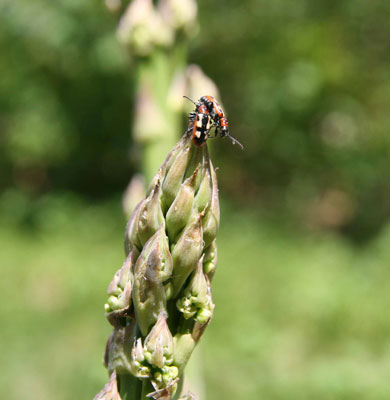 |
| Common asparagus beetles |
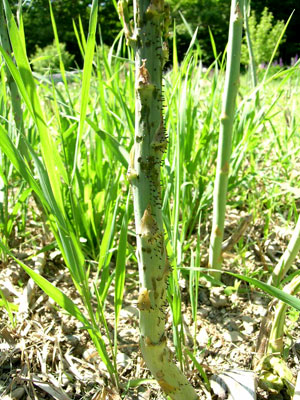 |
| Common asparagus beetle eggs |
The Beetles
I have seen both kinds of asparagus beetles here already. Usually the spotted asparagus beetle becomes active somewhat later in the spring, and in my experience is less common (I guess with the names that is not a surprise). These two beetles are closely related and have similar life cycles, but it is the common asparagus beetle that is most damaging to the spears.
Common asparagus beetles
Common asparagus beetle (Crioceris asparigi) is blue-black, shiny, smooth and about 6 to 9 mm (1/4 inch) long, with three large yellow, squarish spots with red margins along each wing cover. Eggs are black, laid standing on end in rows along the spears, and hatch in 3-8 days. Larvae are wrinkled, plump, hump-backed, and dull gray with black head and legs. Some people call them “worms”. They grow up to 1/3 inch. These larvae feed in spears and in ferns. The larvae do the most damage, and eggs and larval damage makes spears unmarketable. Larval feeding can cause severe defoliation and weaken the stand. When full grown, larvae drop to the soil and pupate underground. New adults emerge in July, feed in ferns, and by September are looking for overwintering sites. Both species spend the winter as adult beetles either in field borders or within the asparagus field. Sheltered sites such as under bark or in the stems of old plants are preferred. Some burrow into the soil.
Common asparagus beetle eggs
Spotted asparagus beetle (Crioceris duodecimpunctata) is reddish orange or tan, with six black spots on each wing cover (hence its other name, 12-spotted asparagus beetle). Eggs are greenish, glued singly on their sides to leaves. Eggs are laid on fronds, not on spears. Larvae are similar to those described above, but are orange colored, and feed almost entirely inside the berries so they affect seed production but do not hurt the plants.
Cultural Controls
During harvest, you can greatly reduce the population by harvesting ALL of the ready spears every harvest. Do not allow any spears to develop into fronds until you are all done harvesting for the season. This reduces the number of stems where eggs will survive, and larvae can feed and grow up into the summer-generation beetles.
In the fall remove all of the crop residue and other refuse nearby that provides shelter for adults over winter. Maintaining a clean environment in the fall will force beetles to seek shelter outside the field or burrow in the soil, where many predators reside.
Biocontrol
The most important natural enemy of common asparagus beetle is a tiny parasitic wasp (Tetrastichus asparagi) that attacks the egg stage. Wasps kill eggs by feeding on them (sucking them dry), and also lay their own eggs inside the beetle eggs. The immature wasps grow inside the beetle larvae, killing them when they pupate. Studies have found >50% of eggs killed by feeding and half of the surviving larvae parasitized. Providing a nearby nectar source such as umbelliferous flowers may enhance wasp populations.
Monitoring and Chemical Control
Scout fields regularly. You may want to treat spears if >10% of the plants are infested with beetles. The daily harvest makes treatment difficult because few want to spray anything close to harvest time. Treating infested fronds is important. Organic options include Entrust (Monterey Garden Spray for gardeners). Surround WP may work as a repellent.
Thanks to: Ruth Hazzard (U. Mass Vegetable Notes & The New England Vegetable Management Guide), and Brian Caldwell, Cornell University
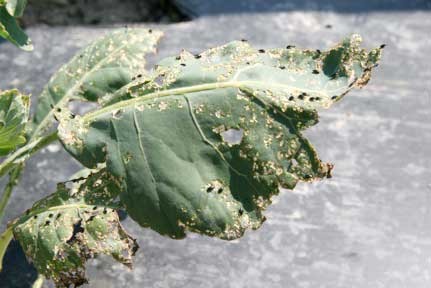 |
| Flea beetles on broccoli leaf |
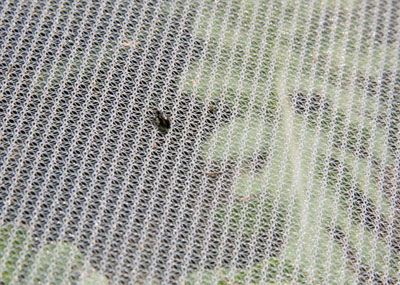 |
| Flea beetle trying to get through Proteknet. |
FLEA BEETLES IN BRASSICAS
Flea beetle numbers are likely to rise in coming weeks here in Maine as beetles move out of field borders where they spent the winter. Crucifer and striped flea beetles feed on brassica crops as well as weeds that are in the same family, such as yellow rocket or wild mustard. (It is a different species of flea beetles that feeds on the tomato family of crops. This is important information when planning rotations of potatoes or tomatoes with brassica cash or cover crops).
The crucifer flea beetle (Phyllotreta cruciferae) is uniformly black and shiny, about 2 mm in length, while the striped flea beetle (Phyllotreta striolata) has two yellow stripes on its back. Flea beetle adults feed on leaves and stems, resulting in numerous small holes, or ‘shot-holes’. Eggs are laid in the soil starting in late May, and beetle larvae feed on roots. The non-waxy greens (arugula, bok choi, tatsoi, mustard, Chinese cabbage, komatsuna) are preferred to the waxy cabbage, kale and collard types of brassicas. In brassica greens, beetles feed on the whole surface of the leaf, and will continue feeding from the seedling stage until harvest. Waxy crops are most susceptible at the cotyledon and seedling stage and feeding is more limited to leaf margins on older plants. Some crops simply outgrow the beetle pressure and the damage can be tolerated. No damage can be tolerated in leafy greens crops such as arugula.
To reduce and delay flea beetle invasion of spring crops, move them as far away as possible from the fields that were used for brassica crops last fall. Beetles overwinter in field borders near last year’s crop. Planting the same crop close by to where it was last year ensures a high population in the spring. The same could be true if you have fields full of mustard weeds, or move to a field that was seeded to a brassica cover crop the previous year.
One of the best ways to protect brassica crops from flea beetles is to place a floating row cover, or exclusion netting, over the bed or row. It is critical to seal the edges immediately after seeding or transplanting, because brassica seeds germinate quickly and beetles rapidly find the cotyledons. Flea beetles can fit through extremely tiny cracks. Edges of the cover must be sealed on all sides using soil, plastic bags filled with soil, or some other method.
Spinosad (Entrust is the organic formulation for farmers, and Monterey Garden Spray is one for gardeners) is sometimes effective in suppressing flea beetles and reducing damage. Pyrethrin (Pyganic) showed poor to moderate efficacy in trials, and has a short residual period. Yet some growers have reported a good knockdown with this product.
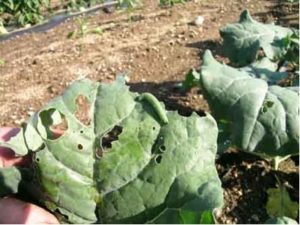 |
| Imported cabbageworm and feeding damage |
IMPORTED CABBAGEWORM
By Eric Sideman
Finding the white moth with the dark marks on its wing flying in large numbers around brassica vegetables is a troubling sight. You may find the eggs they lay, and the tiny caterpillars that hatch. I only notice them after I see the holes and chunks chewed out of the leaves. It is much better to spot them early, so scout often. Even if you cannot see the eggs, it is much easier to manage them when they are still tiny caterpillars.
The pest overwinters as a pupa in crop debris and is a common pest every year. The imported cabbage worm is the most common of three different caterpillars often found feeding on cabbage, broccoli, Brussels sprouts, kale, etc. The other two caterpillars often seen feeding on brassica crops are the diamondback moth and the cabbage looper. The looper does not overwinter in the north, and any overwintering of the diamondback is spotty at best.
These pests are usually carried up here by storms. Hence problems from these pests vary from year to year, and are usually less common than the imported cabbageworm.
All three pests produce multiple generations each growing season. It is important to destroy the crop debris after harvest so as not to harbor future generations that will move onto your later plantings. Controlling brassica weeds will help. Row covers will work however these crops do not do well in heat so there could be problems in warmer weather, unless you switch over to exclusion netting which allows greater air-flow.
Bt gives good control of all three caterpillars, if applied while they’re still young enough to be feeding. Dipel is a common brand. Spinosad works even better, but is more expensive. Be sure to scout the crops and spray only when the pest is present. Bt must be eaten to work and since it degrades quickly in sunlight it should be sprayed when the pest is actively feeding. There is no protective activity. As usual, if you are a certified grower be sure that the formulation you use is approved for organic production.
By the way, the imported cabbageworm also feeds on lettuce.
